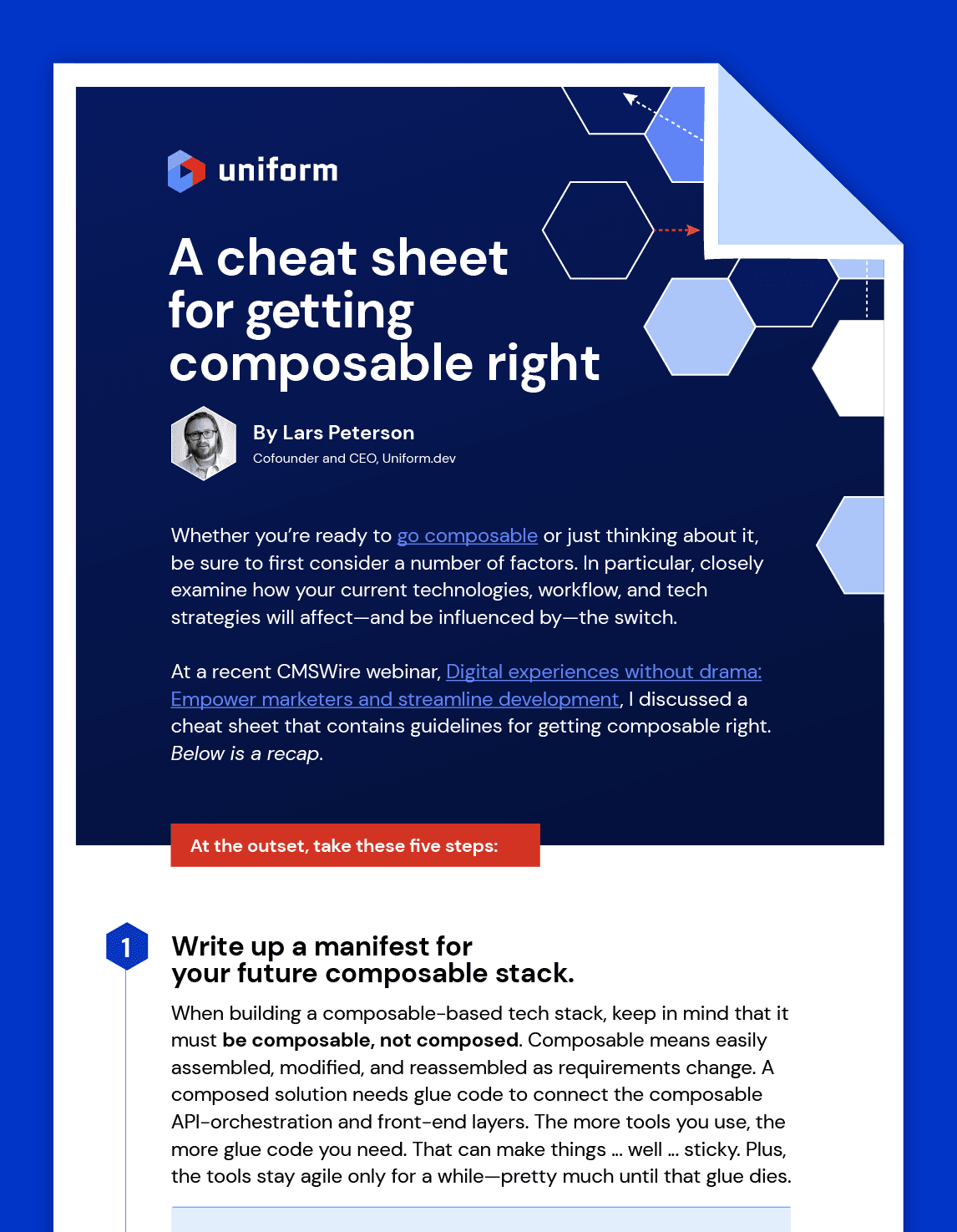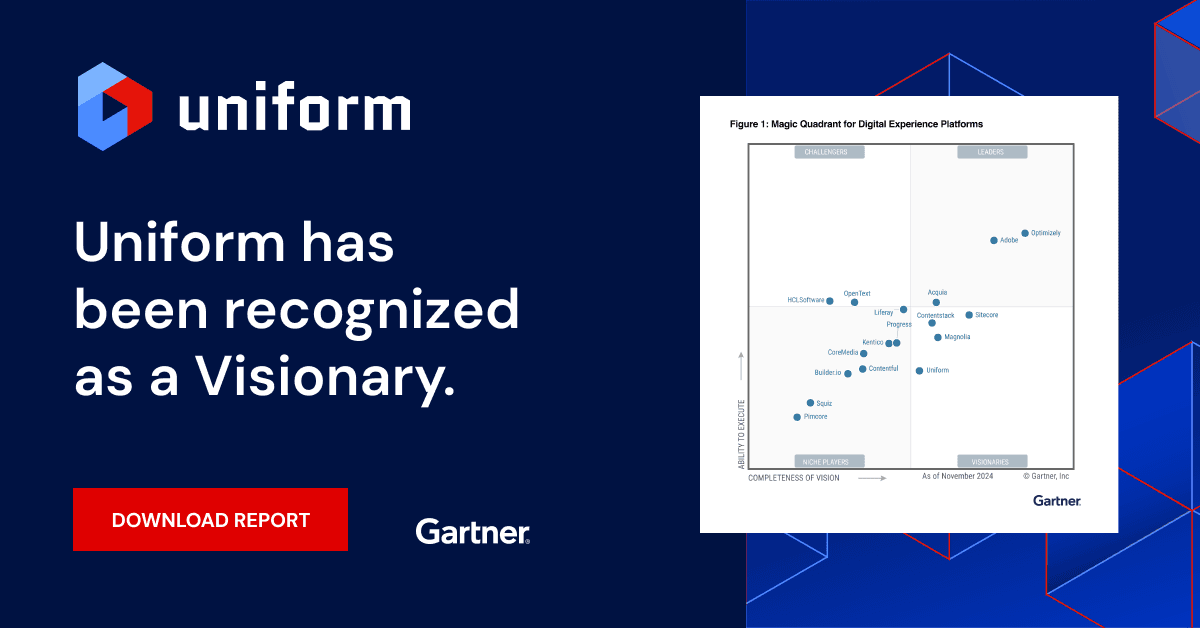Uniform blog/Headless versus composable: everything you need to know
Headless versus composable: everything you need to know
Headless versus composable: everything you need to know
In the universe of creating digital experiences, the terms “headless” and “composable” are generating a lot of buzz. Talk abounds of headless solutions and composable architectures along with their offerings for e-commerce companies that are vigorously seeking a competitive advantage.
However, headless and composable are not interchangeable concepts. To do an effective job, marketers and other business users must understand what those concepts mean and do—and do not mean or do not do.
In a nutshell, products are headless and architectures are composable. Read on for a comprehensive overview in simple terms.
The pros and cons of headless products
Always sold for purchase, headless products offer the enticing premise of storing, managing, and delivering content with the front end decoupled from the content or commerce layer, called the “head.” However, headless products cannot display data or content in channels. For instance, you can create content for webpages but cannot build them with a headless CMS.
Headless advantages
- Flexibility. Instead of a one-size-fits-all technology that tries to accommodate everyone, headless with its main feature of a decoupling of the front end and back end enables brands to select the best technology for their unique requirements—be they performance, scalability, or simplicity.
- Superior user experience. Brands are free to deliver the exact kind of experience they desire to users, unlocking the creativity and craftsmanship of their designers and front-end developers during the process.
Headless disadvantages
- Business teams are disempowered. Since headless completely disconnects the content-authoring process from content display across channels, business users cannot build channel-specific experiences. Instead, developers must take on that task.
- Technical teams have a heavier workload. Building and maintaining channel-specific experiences is not particularly rewarding or stimulating for developers, not to mention that the additional workload presents them with a difficult choice: either tackle the development-oriented tasks that require their expertise or oblige business teams’ requests vis-à-vis creation of digital experiences.
The pros and cons of composable architecture
Through composable architecture, a design pattern established around reusable components, developers can quickly and easily build applications and other digital elements. Why? Because that architecture solves all the problems created by the legacy, “all-in-one” solutions for generating digital content and commerce.
Also, as requirements evolve, brands can more easily assemble, modify, and reassemble components with composable architecture—without major rebuilds. However, composable architecture is not available for purchase, and brands must build it themselves.
Composable advantages
- Flexibility. Thanks to composable’s modularity, brands can use only the products they need and swap new products in and out of their digital stack as necessary.
- Incremental adoption. Since composable is inherently flexible, organizations can progressively build new architectures and slowly replace legacy solutions.
Composable disadvantages
- Complexity in development. The fact that no two composable architectures are the same spells problems for workforce management. Developers who move on to other horizons invariably take with them intricate knowledge of the system, and new hires always face a learning curve.
- Complexity in workflow. Composable complicates the workflow of marketers and business users, who must switch back and forth between tools within the stack. In addition, because you can implement functionality in multiple products, users might be hard pressed to decide which one to use.
A glance at what can go wrong
Even though organizations that desire to optimize digital creation are best served by headless products in a composable architecture, the journey toward that power combo could be thorny. A common pitfall is that the design that companies build with headless products might prevent them from reaping the full benefits of composable.
Not only that, some companies jump through hoops to find products that are MACH [Microservices-based, API-first, Cloud-native, and Headless] certified, only to end up with a MACH monolith that accords them few of the benefits they were hoping for. Often enough, companies that leverage MACH get stuck with an in-between version of the old, legacy-suite approach and the new composable way of designing architectures, leaving marketers and content creators relying on developers for more common tasks.
Again, products are headless; architectures are composable. The difference is that headless is a tactic and composable is a strategy. Therefore, the resolution lies in digital experience composition platform (DXCP).
A way to achieve sustainable composability
The Uniform DXCP features a no-code orchestration layer that offers sustainable composability, bridging the gap between the promise and the reality of headless products and composable architecture. Besides, Uniform DXCP also orchestrates headless products so that they become usable in a composable architecture.
Above all, through Uniform, the headless products in a composable architecture work together as a single system instead of a collection of products.
An enhanced workflow follows, whereby marketers and other business users can independently build digital experiences without involving developers, freeing them up to focus on higher-value development projects.
To find out how the Uniform DXCP can kickstart your headless and composable stack, contact us for a demo.

A cheat sheet for getting composable right!
Start your composable journey!




.png&w=1080&q=90)
.png&w=1080&q=90)
.png&w=1080&q=90)